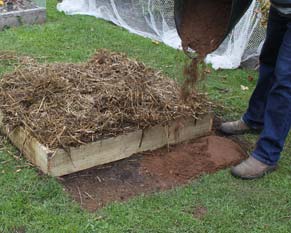vegetable patch design
building a raised bed
building a raised bed - Page 2
4. dig out the pathways


- With a spade cut an edge where you want the path to go to a depth of about 6 to 10 Centimetres, the same as you did for marking the base of the frame in Step 3.
- Driving the blade of the spade in at a low angle peel the
grass up in sections.
- Flip the removed clods of grass upside down in the bed.
Place the clods as evenly as possible in the bed, try not to create a mounds. - Scrape out any loose soil so that the path section is down to roughly the same depth as the bottom of the frame.
5. cover and fill the bed


- Cover the base of the bed with several sheets of
newspaper and tuck the newspaper in tightly at the edges.
- Add a mixture of good quality soil, compost, sheep, cow and
chicken manure, straw, pea straw, lucerne (Alf Alfa). Some sand
and a little rock dust can also be added but this is not
essential.
Any combination is fine as long as you have some kind of straw, manure and a little garden soil. It's best to use what is cheapest and easiest for you to get. The balance of the soil can be adjusted in the first couple of seasons, the important thing is to get plenty of organic matter that will break down into good soil. - Pile this mixture up above the top of the raised bed then
trample it down as much as possible.
This is because as the organic part of the mixture breaks down it will shrink in size. When first filled the bed might be full to the brink but within three months the top will settle to below the top of the frame.


6. cover the top with a
final layer


- Cover the top with four or five sheets of newspaper then
top off with a layer of straw, pea straw or lucerne.
Again do not worry if the straw is above the top of the raised bed as it will settle as the organic matter breaks down. You can trample down this final layer but if you do so try not to tear the paper layer. This second layer is thinner and sitting on softer material so it is easy to put your boot through it if you are not careful.
- Add gravel to the path until it is level with the
surrounding ground.
There are a number of gravel type mixtures that will do the job. My preference is to use granite sand, however this may not be available outside of Australia.


7. Fallow the bed before planting
out
Though the bed is now completed it should be
left for at least two or three months before planting out.
This is to allow time for the various materials you have added to break
down into a more soil like structure.
